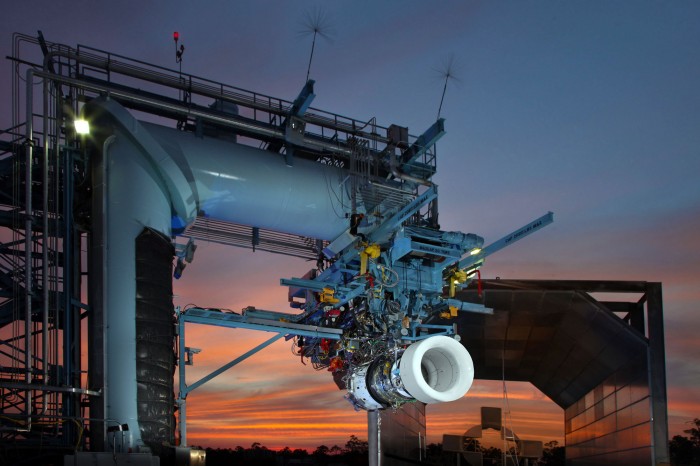The Race for the Ultra-Efficient Jet Engine of the Future
The commercial aviation industry emits 705 million metric tons of carbon dioxide each year. While that represents only about 2 percent of global carbon emissions, there is evidence that the greenhouse gases in jet fuel have a larger effect on the atmosphere because they are released at high altitude. Efforts to introduce biofuels to power jet engines have so far fallen short of their targets, and many in the industry believe the pathway to cleaner jets is through advances in engine technology rather than cleaner fuels.
That’s the idea behind the fierce competition to supply tomorrow’s aircraft with engines that are much lighter, quieter, and more energy-efficient than the conventional turbofan engines used on airliners today. Pratt & Whitney says its new engines—which use an internal gearbox to slow down the speed of the fan—could save 20 percent on fuel consumption compared to an airliner with a conventional engine. Competitor CFM International, meanwhile, has introduced its own advanced engine, called the Leap, which could achieve similar improvements without such a radical break from existing technology. Both new engines have been deployed on different versions of Airbus’s new jet, the A320neo.

Turbofan engines use a large-diameter fan to pass air through the engine and have dominated commercial aircraft since the 1960s. Pratt & Whitney spent more than 20 years and $1 billion developing its new geared turbofan engines, which use larger fans (up to 81 inches in diameter on the A320neo) and a gearbox to make the fans rotate more slowly than the internal turbine that drives them, making them more efficient than traditional engines. Adding the gearbox, however, makes the engines heavier and increases aerodynamic drag.
CFM International, meanwhile, says it can achieve many of the same benefits using a conventional turbofan architecture, without the added weight and drag of a gearbox. The Leap engine uses lightweight composite materials, such as carbon fiber fan blades, to achieve energy efficiency gains that the company says are comparable to those of the Pratt & Whitney engine. The Leap represents “the ultimate refinement of the traditional turbofan engine,” says aviation analyst Richard Aboulafia, vice president for analysis at the Teal Group.
The two directions for the world’s leading makers of jet engines contrast sharply: “Typically new engine designs are different flavors of vanilla,” Aboulafai says. “This is the biggest diversion in propulsion philosophy that we’ve ever seen with two competing engines.”
So far Airbus’s engine orders for the A320neo have been split between CFM and Pratt & Whitney models. More than 7,000 pre-orders have been placed for Pratt’s new engines—a remarkable number, particularly in a period of low fuel costs. Last month, however, Qatar Airways, a large early customer of the A320neo, rejected delivery of the planes, citing concerns with cooling the new geared turbofan engines from Pratt. Airbus said the issues will be resolved by midyear and deliveries to Qatar will resume.
Regardless of who wins the race for the next generation of airliners, experimental designs for jets that will reach the market in midcentury promise huge advances in reducing carbon emissions and noise from commercial aircraft.
Late last month, NASA administrator Charles Bolden announced a new program to develop advanced aviation technologies that will reduce carbon dioxide emissions from jet aircraft by more than half. The space agency will support R&D on a number of experimental aircraft, including the D8, a novel jumbo-jet design being developed by a partnership that includes Pratt & Whitney, MIT, and Aurora Flight Sciences. Those involved say the D8 could burn 70 percent less fuel than today’s aircraft.
Keep Reading
Most Popular
Large language models can do jaw-dropping things. But nobody knows exactly why.
And that's a problem. Figuring it out is one of the biggest scientific puzzles of our time and a crucial step towards controlling more powerful future models.
How scientists traced a mysterious covid case back to six toilets
When wastewater surveillance turns into a hunt for a single infected individual, the ethics get tricky.
The problem with plug-in hybrids? Their drivers.
Plug-in hybrids are often sold as a transition to EVs, but new data from Europe shows we’re still underestimating the emissions they produce.
Stay connected
Get the latest updates from
MIT Technology Review
Discover special offers, top stories, upcoming events, and more.